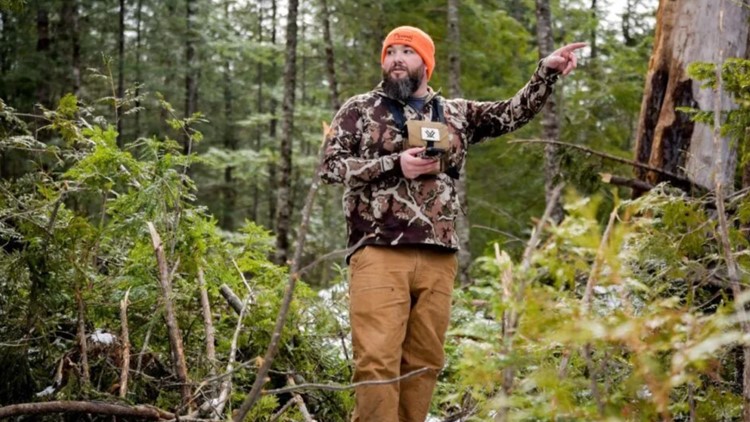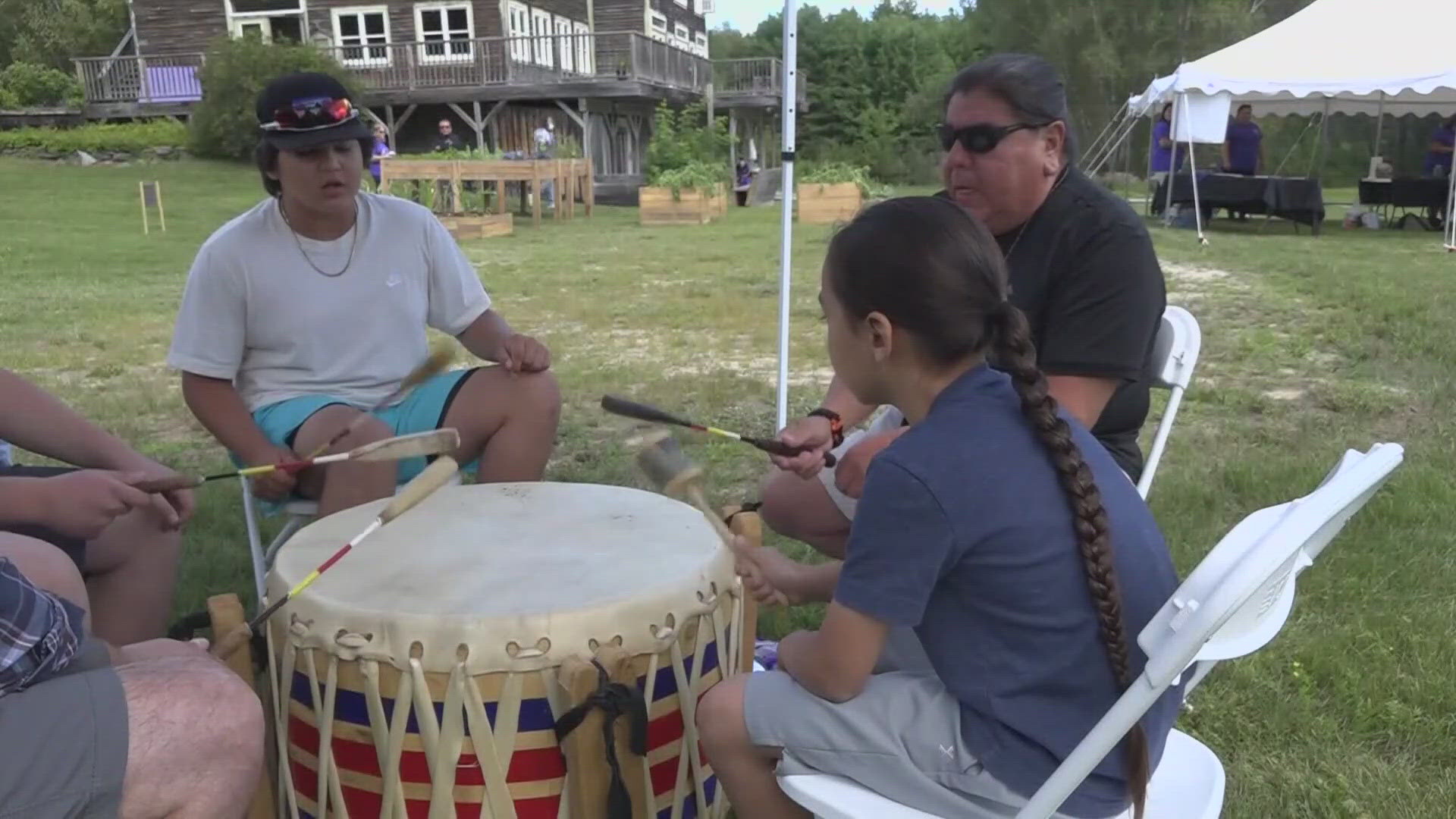MILLINOCKET, Maine — Wearing an orange beanie and a camo jacket, Charles “Chuck” Loring Jr. trekked through the forest just north of Howland, a compact layer of snow crunching beneath his feet.
Logging machinery hummed in the distance. He paused and looked around with a hunter’s eyes, then said, almost in a whisper, “Yeah, this smells moosey.”
It was late February, well past the Penobscot Nation’s fall moose hunting season. But as he navigated the topographical maps on his phone, searching for a boundary line, he was also keeping an eye out for a dropped antler or two.
Loring, a member of the Penobscot Nation and the tribe’s director of natural resources, was letting me tag along while he checked on the progress of a timber harvest on tribal lands.
As we zoomed down the logging roads, he pointed out how beaver dam washouts shifted water distribution and explained how stream drainage could be improved.
Loring studied forestry just down the river from Indian Island, at the University of Maine in Orono, but his education goes deeper than academic instruction: His family has a long history of protecting and managing the tribe’s resources.
When I met him earlier that day, among the fly fishing waders and moose antlers dotting his office I spied a framed and faded Penobscot Nation Warden Service uniform that belonged to his grandfather.
Loring supervises more than 20 people, overseeing everything from air quality and brownfields to forestry and fisheries. He manages the natural resources on more than 128,000 acres of Penobscot Nation land — but his job is about to get bigger.
The Trust for Public Land is working with the Penobscot Nation to return 30,000 acres near Mount Katahdin to the tribe, which would solidify Wabanaki sovereignty over land their ancestors have stewarded for generations.
The parcel would create a contiguous stretch of conserved land from existing Penobscot Nation holdings near the East Branch of the Penobscot River all the way to Jackman and Moosehead Lake, combining to form 1.2 million acres.
The land — which is being called Wasehtek, a Penobscot word that corresponds to the East Branch of the Penobscot River — was owned by Conservation Resources, a timber investment management organization. In December 2022, the Trust for Public Land announced it had purchased the property for approximately $29 million.
The land is currently accessed by a limited network of logging roads, which vary in quality. With over 53 miles of rivers and streams, and a diverse population of game species, the land offers substantial fishing and hunting opportunities.
This move in northern Maine fits into a nationwide effort to return ancestral lands to Native tribes. The federal Land Buy-Back Program for Tribal Nations, a decade-long initiative that concluded in December, restored nearly 3 million acres to tribal ownership and paid over $1.69 billion to individuals.
Within the nonprofit realm, The Nature Conservancy, The Conservation Fund and the Trust for Public Land have worked to return hundreds of thousands of acres to Indigenous groups. (The popular television show “Reservation Dogs” also mentions the concept.)
Once the land is transferred into Penobscot hands, the tribe plans to use it as a source of timber as well as a place to fish and hunt. Loring said forestry won’t begin for a few years because the tribe has a strict set of guidelines for timber harvesting.
Penobscot forestry practices involve prioritizing the river habitat and reducing erosion by selecting trees farther from the water’s edge. This helps keep riverbanks shady and protects threatened fish like the Atlantic salmon.
The Penobscot Nation’s fish and game laws are distinct from those of the state, and part of Loring’s job is to ensure resources are managed sustainably so tribal members and non-members alike can hunt and fish. In the fall, the tribe auctions off several moose hunts, led by Penobscot guides, to non-tribal hunters.
The addition of this land means Loring’s team will grow, but it’s unclear by how much. In riding shotgun with Loring for a day, it was clear the tribe would welcome more land for timber harvests and recreation tourism opportunities. This is to say nothing of the ways Indigenous stewardship can increase biodiversity, which in turn supports climate resilience.
Despite living in what we now call Maine for thousands of years, Wabanaki tribes hold roughly 1 percent of land in the state, according to a 2022 report by the Maine Permanent Commission on the Status of Racial, Indigenous and Tribal Populations.
The land return follows decades of work by groups advocating for greater tribal sovereignty in the region, said Darren Ranco, a member of the Penobscot Nation and professor of anthropology at the University of Maine.
He pointed to the Maine Indian Claims Settlement Act of 1980 as a watershed moment. The act, signed by President Jimmy Carter, awarded the Passamaquoddy and Penobscot tribes $81.5 million (equivalent to roughly $305 million today) in reparations for land taken following an extended legal battle between the tribes and the state.
Though it was initially viewed by many as a victory on both sides, its implementation has been fraught, and many believe the state’s ensuing ability to block federal Indian policy has reduced the tribes’ sovereignty and economic resilience.
A 2022 study by the Harvard Kennedy School concluded that the act limited Wabanaki per capita income growth to 9 percent, compared to an average of 61 percent among the other 570 federally recognized U.S. tribes.
Last month, Wabanaki leaders and Gov. Janet Mills’ administration signaled a willingness to work together on new legislation that would address tribal concerns about sovereignty, including giving the Penobscot and Passamaquoddy tribes greater flexibility to acquire land.
“More recent work by people like the Wabanaki Alliance has mobilized and centered Wabanaki perspectives and voices about place and justice in ways that we haven’t seen before,” Ranco said.
Brett Ciccotelli, who works for First Light — a collaboration of Maine’s conservation groups and four Wabanaki tribes — explained how land-based groups are working with Indigenous leadership, pairing the conservation community’s ability to acquire land with Wabanaki priorities.
“We’re learning together, understanding history differently and understanding relationships. For conservation organizations and people within Wabanaki territory, it’s an effort to help those groups to re-center Wabanaki people in that work,” he said.
The collaborative work between First Light and the Wabanaki Commission on Land and Stewardship has already resulted in success. The 140-acre Kuwesuwi Monihq (Pine Island) was returned to the Passamaquoddy in 2021 after more than 150 years of dispossession. The island, which was renamed White’s Island by settlers, was once a place where tribal members delivered supplies to those quarantined during the smallpox epidemic.
In its land return efforts, First Light has also emphasized educating people about the history of colonization in Maine and its impact on Wabanaki people, including policies like the Phips Proclamation of 1755, in which the colonial government offered bounties for the scalps of Wabanaki men, women and children. Wabanaki-led NGOs such as Wabanaki Public Health & Wellness, Nibezun and Wabanaki REACH also promote education and restorative justice.
Parcels of undeveloped land this large don’t come up for sale often, especially in the eastern United States. According to the Trust for Public Land, this transfer near Mount Katahdin is “the largest land return between a U.S.-based nonprofit and a tribal nation.”
The 31,367 acres of land contain waterways that comprise an important part of the broader Penobscot River ecosystem, as well as culturally significant resources like sweetgrass and ash trees, used for basketry and other art forms.
Betsy Cook, who is The Trust for Public Land’s state program director, said that when the nonprofit learned of the timber company’s plan to sell the land in May 2022, her group reached out to the National Park Service because of the land’s proximity to the NPS-managed Katahdin Woods and Waters National Monument, and to Penobscot tribal leadership to see if they were interested.
“We initiated conversations with the Penobscot Nation and asked, essentially, what their interest would be in working with us, and it was really, really high, which we were super excited to hear,” she said.
The Trust for Public Land hopes to raise $32 million — $29 million to repay loans and $3 million for real estate costs, organizational expenses, accrued interest and taxes, and a stewardship fund for the Penobscot Nation. The group hopes to finish its fundraising and transfer the land by mid-2026. As of late February, it had raised $6.1 million.
One of the Trust for Public Land’s hopes for the project is it will allow the National Park Service to create a new entrance to the Katahdin Woods and Waters National Monument, which is currently accessed from Route 11.
Visitors coming from the south have to drive up I-95, then venture west from Sherman, depriving the current adventure tourism hub of Millinocket from offering lodging, food and other services that are already in place.
Many also see the land return as an opportunity to reconsider what conservation looks like. Studies have found that Indigenous-managed lands have biodiversity levels equal to or greater than protected lands, and conservationists have become increasingly interested in what is known as Traditional Ecological Knowledge.
As the climate changes and biodiversity wanes in the face of monocultures, pesticides and pollution, Indigenous approaches to land management can offer conservation groups new ideas and techniques.
Rather than viewing land as something to be extracted to make money or something to be preserved as total wilderness, Ranco said Indigenous communities have traditionally taken a view that emphasizes interconnectedness.
Ronco said when people feel connected to the land, they naturally develop a desire to take care of it.
“It’s not humans that are the problem,” he said, “but a certain set of values.”
As Loring drove through the tribal lands, he stopped to talk to a timber harvest contractor named Gene Fogg. They shared a laugh while comparing notes on the spruce harvest, and discussed the perpetual disappointment of new guys on the job.
A giant pile of freshly cut wood, soaking up the heat of an abnormally warm winter day, filled the air with a familiar and comforting scent.
When I asked Loring if there was any desire to keep non-tribal members off the land, he said, “Other than the mud season gates on the roads, people are allowed to have access.”
This story was originally published by The Maine Monitor, a nonprofit and nonpartisan news organization. To get regular coverage from the Monitor, sign up for a free Monitor newsletter here.



